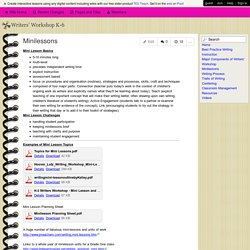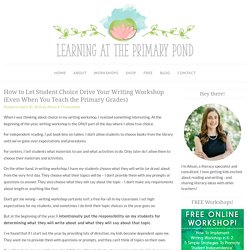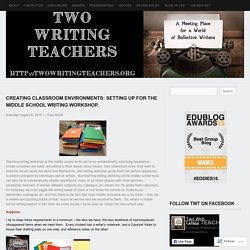

Writers workshop mini lessons Lucy Calkins. Writers' Workshop K-6 - Minilessons. Mini Lesson Basics5-10 minutes longmulti-levelprecedes independent writing timeexplicit instructionassessment basedfocus on procedures and organisation (routines), strategies and processes, skills, craft and techniquescomposed of four major parts: Connection (teacher puts today's work in the context of children's ongoing work as writers and explicitly names what they'll be learning about today); Teach (explicit teaching of one important concept that will make their writing better, often drawing upon own writing, children's literature or student's writing); Active Engagement (students talk to a partner or examine their own writing for evidence of the concept); Link (encouraging students to try out the strategy in their writing that day or to add it to their toolkit of strategies)Mini Lesson Challengeshandling student participationkeeping minilessons briefteaching with clarity and purposemaintaining student engagement Examples of Mini Lesson Topics Mini Lesson Planning Sheet.

CEAP HS BK LisaCleavelandConfMaterial. How to Let Student Choice Drive Your Writing Workshop (Even When You Teach the Primary Grades) - Learning at the Primary Pond. When I was thinking about choice in my writing workshop, I realized something interesting.

At the beginning of the year, writing workshop is the ONLY part of the day where I allow true choice. For independent reading, I put book bins on tables. I don’t allow students to choose books from the library until we’ve gone over expectations and procedures. For centers, I tell students what materials to use and what activities to do. Only later do I allow them to choose their materials and activities. On the other hand, in writing workshop, I have my students choose what they will write (or draw) about from the very first day. Don’t get me wrong – writing workshop certainly isn’t a free-for-all in my classroom. But at the beginning of the year, I intentionally put the responsibility on my students for determining what they will write about and what they will say about that topic. I’ve found that if I start out the year by providing lots of direction, my kids become dependent upon me. Edutopia.
Creating Classroom Environments: Setting up for the middle school writing workshop. Teaching writing workshop at the middle school level can be an extraordinarily satisfying experience: middle schoolers are ready and willing to think deeply about issues, they understand more, they want to examine issues about the world and themselves, and writing workshop gives them the perfect opportunity to stretch and grow as individuals and as writers.

But teaching writing workshop at the middle school level can also be an extraordinarily chaotic experience: many of us share spaces with other teachers, sometimes teachers of entirely different subjects (my colleague Jen shares the 7th grade Math classroom, for instance), we must juggle the writing needs of three or four times the number of students our elementary colleagues do, and then there is the fact that most middle schoolers are a hot mess – they are a volatile and puzzling bunch of kids, much as we love and are amused by them.
The Literacy Shed - Home. Sentence Practice - The Applicious Teacher.
Genres and tasks. Note Taking Skills for 21st Century Students. Note taking skills aren’t just automatic.

We tell students “take notes” but they have no idea what that means. What makes “good notes.” What do they write down? How should notes look? Ever since I went through the Writing Across the Curriculum Course at my school I realized the tremendous gap between “writing” as we’ve taught it traditionally and 21st century writing skills. Now I have a new frustration that has me grappling with noteaking. So, now, I’m taking the approach of helping students master analog notetaking.
A note about In-Flip: The kids love it. I want to know what they are getting out of the videos and if they are pulling out the essential questions I’m giving them. So, here are some of the essential notetaking skills I’ve taught them so far. Cornell Notetaking System My favorite Cornell notetaking video is by Jennifer DesRochers. This method is THE SINGLE MOST important reason (besides studying myself blind) that I graduated first in my class from Georgia Tech.
You did it! Blogging for Reluctant Writers: Have students share their ideas using sound and video. For students who love to write, composing blog entries is a natural—and effective—way to share their stories and ideas with a wider audience.

Reluctant writers can have great ideas, too—they just don’t want to write them down. Fortunately, there’s more than one way to tell a story. Here, we’ll examine some excellent video and audio tools and how they can be used to help students craft dynamic content for classroom blogs. Edited video with SOund Free tool Wideo.co lets you make short, animated videos in your Web browser. Students can make their own audio recordings using SoundCloud.
SoundCloud apps come in handy for a variety of projects. Audio slideshows Animoto is of the best-known tools for making audio slideshows and has long been a classroom favorite. Narrable (pictured above), launched earlier this year, is another audio slideshow application. 10 Good Apps & Sites for Creative Writing Projects. Student Self-Assessment Practices That Work - Work in Progress.
The Literacy Shed Blog - DADWAVERS BLOG. Welcome to Literacy WAGOLL! - Home.